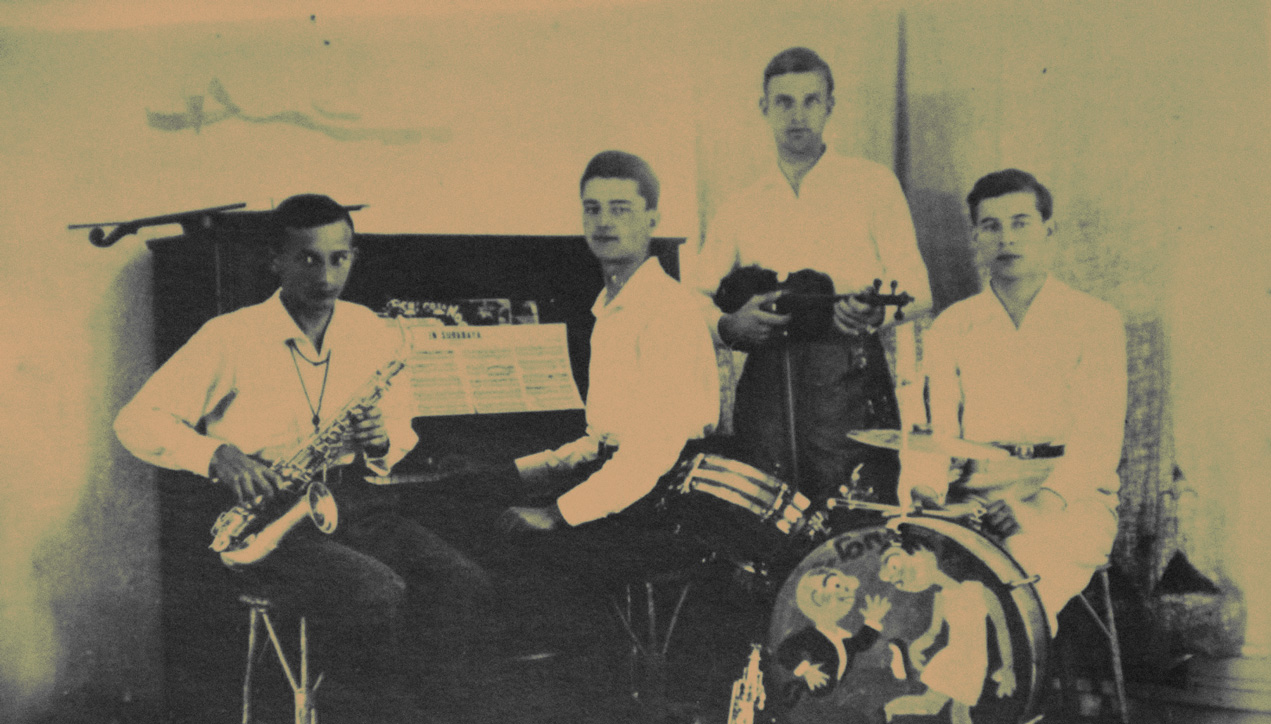
 |
Yabtso Jazz: swinging Lviv in the 1920s-30s |
Post Reply 
|
| Author | |
snobb 
Forum Admin Group 

Site Admin Joined: 22 Dec 2010 Location: Vilnius Status: Offline Points: 30475 |
 Post Options Post Options
 Thanks(0) Thanks(0)
 Quote Quote  Reply Reply
 Topic: Yabtso Jazz: swinging Lviv in the 1920s-30s Topic: Yabtso Jazz: swinging Lviv in the 1920s-30sPosted: 21 Jul 2020 at 5:34am |
Bondi Vesolovsky and Yabtso Jazz: swinging Lviv in the 1920s-30s Leonid “Yabtso” Yablonsky (3rd from the left, with violin), 1931 Leonid “Yabtso” Yablonsky (3rd from the left, with violin), 1931 In the 1920s, the nightlife scene in
Lviv was dominated by all-night parties, live music and swinging dance
floors. The interwar period was a distinctive and important moment of
modernity in the 20th century, from the rise of the metropolis and the
emergence of new forms of mass media to the changing lifestyles of women
and the search for new forms of leisure and entertainment.
Ukrainian students and young people joined the worldwide trend, looking to create something new, refreshing and modern. Young Lvivers were fascinated by Western culture and centred their leisure time on cafés, cabarets and jazz venues. “Clubbing” was not only a new ritual, but also a way of living. Slick hipsters in evening attire gathered on dance floors, at balls and all-night parties, flirting, drinking and listening to jazz, tangos and swing. Towards the end of the 1920s, the revue genre spread in Lviv cafés, cabarets and night clubs, introducing music, jokes, parodies and shows with theatrical elements. Of course, at that time in Polish-ruled Western Ukraine, the Lviv
night-club scene was dominated by Polish jazz bands. Lvivers danced to
the music of Warsaw composers, such as Tadeusz Faliszewski, Henryk Wars
and many others, as well as cover bands mimicking or re-interpreting
original Italian and German hits. During this period, Ukrainian-language
music was limited to nostalgic songs about the countryside and cherry
orchards that most young people perceived as unbearably out-dated and
boring. However, more and more young Ukrainians turned to creating and
popularizing modern music in the Ukrainian language. This movement was
also supported by Ukrainian nationalist organizations, which sought to
encourage patriotism and Ukrainian music, calling “to eliminate futile
and boring Polish pop music” and encouraging local musicians to compose
trendy musical hits in Ukrainian. And so it began… in 1930, the first true “pop stars” of Ukrainian music, the jazz cappella led by Leonid Yablonsky, also known as Yabtso Jazz, took root and spread its unique sound all across the city and the western region of Lviv. YABTSO JAZZYabtso Jazz included several young men born into patriotic Ukrainian families. Leonid “Yabtso” Yablonsky was the son of a colonel of the Ukrainian National Republic (UNR). Anatoly “Tatsi” Kos-Anatolsky was also the son of a Ukrainian colonel and the Kos-Anatolsky family counted several famous lawyers, doctors and diplomats. Stepan Huminilovych came from a family of teachers and professors. Iryna “Rena” Yarosevych
(stage name – Renata Bohdanska; later known as the Polish star Irena
Anders) was the daughter of a chaplain serving with the Ukrainian Sich
Riflemen; she joined the Yabtso group in 1937-38. But, the driving
force behind Yabtso Jazz was Bohdan “Bondi” Vesolovsky ,
who was born in a family of provincial politicians. Not only did
Veselovsky study music, but he also he received a law degree with the
intention of launching a political career. The band gave its first concerts in the Carpathian resort town of Hrebeniv frequented by intellectuals and the “refined elite” (at different periods, Archduke Franz Ferdinand of Austria, Ukrainian Metropolitan Andrey Sheptytsky, Winston Churchill and other celebrities came here to take the waters). In the daytime, the young men hiked through the mountains, and in the evenings, they gathered to play their music for the holidaymakers. Before joining Yabtso Jazz, Bohdan Vesolovsky formed a group of young men that also performed at such parties. It was not yet a jazz band, but more of a teenage barbershop quartet. Veselovsky joined Yabtso Jazz in the mid-1930s as a pianist, accordionist and composer. It was Bondi that composed their first smash hit – the melancholy tango “Прийде ще час” (The time will come… when you will pine for me). Bohdan Veselovsky and the Revellers, Stryy Gymnasium " data-medium-file="https://i0.wp.com/euromaidanpress.com/wp-content/uploads/2020/07/Bohdan-Veselovsky-and-the-Revellers-Stryy-Gymnasium.jpg?fit=300%2C184" data-large-file="https://i0.wp.com/euromaidanpress.com/wp-content/uploads/2020/07/Bohdan-Veselovsky-and-the-Revellers-Stryy-Gymnasium.jpg?fit=960%2C588" class="wp-image-140202 jetpack-lazy-image jetpack-lazy-image--handled" src="https://i0.wp.com/euromaidanpress.com/wp-content/uploads/2020/07/Bohdan-Veselovsky-and-the-Revellers-Stryy-Gymnasium.jpg?resize=654%2C401" alt="" data-recalc-dims="1" data-lazy-loaded="1" width="654" height="401">Bohdan Veselovsky and the Revellers, Stryy Gymnasium In 1937, this song was published on paper and became an instant sales hit. Young Lvivers hummed the tune in bars and cafes, whistled it in trams. Here’s the first version of The time will come…, performed by Mykola Svystun, a future army major in the Ukrainian Insurgent Army (UPA). Yabtso Jazz also created Ukrainian-language covers for European hits. Here’s the world-famous hit La Paloma. Even if you don’t go for retro music, this will pull at your heart strings! Lyrics and musical arrangement: Leonid Yablonsky. Vocal: Myron Eberhardt. In addition to playing at dance halls and reviews, Yabtso Jazz was a popular feature in corporate evenings for such professions as doctors, lawyers, etc. These were more serious events, where Yabtso Jazz often teamed up with another band led by Ivan Kostiuk, thus creating a real live orchestra. Kostiuk wrote a wonderful recollection of the Press Ball organized on Yaponska Street in Lviv, where he and Yablonsky played in 1935 and 1936:
Edited by snobb - 21 Jul 2020 at 5:43am |
|
 |
|
Post Reply 
|
|
|
Tweet
|
| Forum Jump | Forum Permissions  You cannot post new topics in this forum You cannot reply to topics in this forum You cannot delete your posts in this forum You cannot edit your posts in this forum You cannot create polls in this forum You cannot vote in polls in this forum |